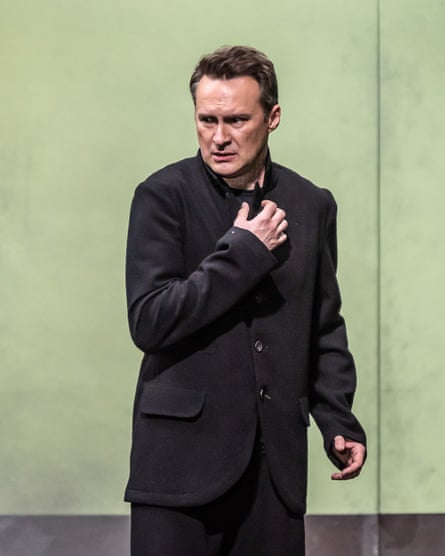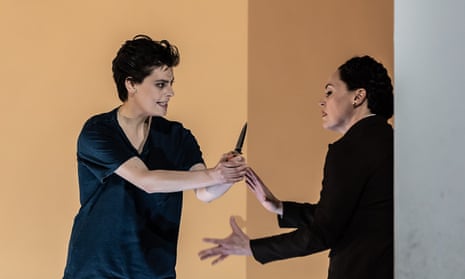The joy was being back. The sorrow, obligatory distancing leaving banks of seats empty, was to share the experience with so few. The Royal Opera House opened last Monday, the first day theatres could function again, with a new production of Mozart’s La clemenza di Tito (1791), conducted by Mark Wigglesworth, directed by Richard Jones and designed by Ultz. It was the company’s first since 2002.
This opera seria – the form celebrates nobility, dignity and, in this instance, clemency – has never won great popularity. Yet Mozart’s late opera, brilliant in musical unity and psychological complexity, can be the richest of all. Wagner, not always right, called it “stiff and dry”. Had he encountered Jones he might have chosen other adjectives. Here is a work dripping with emotion, thwarted honour, stymied intention. In the right hands, you believe these characters.
The stark Jones-Ultz aesthetic won’t charm strict traditionalists. Yet, minor excesses and first-night bumpiness aside, it speaks powerfully and perceptively. As ever with this team (including lighting director Adam Silverman and movement director Sarah Fahie), the staging shows forensic attention to detail.
Classical Rome is indicated by the white pop-up facade of a colonnaded portico. Senators in tweed suits, and a two-roomed interior densely shaded in sage green and brown, place the action in the middle of the last century. With a nod to ancient deities, the emperor Tito arrives like Jupiter come to earth, godlike aura intact, to ambush Servilia, in nylon overall, in the pasta shop where she works. She has other ideas: her honesty, a rare commodity in the face of high office, exhilarates him to the point of laughter.
Tragedy is averted when Tito forgives those who have conspired against him. The question so rigorously investigated here – a joint result of the musical as well as directorial approach – is what it means to be good when so much in life makes us bad. How and why has this emperor, who once killed a man, now put clemency above all else? How, in turn, can sweet Sesto love, to the point of treachery, the ghastly, conniving Vitellia?

As Tito, the tenor Edgaras Montvidas, a former ROH Jette Parker young artist, invested the role with fire, vanity and self-doubt. The mezzo-soprano Emily D’Angelo proved an agile, gauche, tormented Sesto, in command of the role’s wide vocal range. As Vitellia, Nicole Chevalier gave us a creature in meltdown, erupting with regret and frustration, challenged by the lowest notes but soaring at the top. Angela Brower’s sympathetic Annio, Christina Gansch’s plucky Servilia and Joshua Bloom’s tough Publio were expertly taken.
With Wigglesworth keeping the pace brisk but not hasty, bringing out the intricate inner string figurations and opting for the more delicate harpsichord continuo (rather than the meatier fortepiano), the orchestral playing had intensity and clarity, matching the staging itself. Woodwind, including the dazzlingly played clarinet obbligato solos in both acts, horns, trumpets and timpani all played with panache. The ROH chorus mustered as much volume and energy as they could, for distancing reasons hidden away offstage (at the back of the stalls?). You can pay to watch La clemenza di Tito online until 20 June. Nothing, it has to be said, equals being there and feeling the air, if not the earth, move.
In sharp contrast, Current, Rising, described as the world’s first opera in hyperreality, turns the whole experience of opera into a personal and immersive mystery. Wearing a VR headset, and admitted to the 15-minute session with only three other people, we the audience turn protagonist. Only the soundtrack is fully determined. We look and move as we like (if we dare; hyperreality can make the susceptible quake, especially when wearing a face mask as well).
Inspired by the liberation of Ariel at the end of Shakespeare’s The Tempest, the pioneering video artist Netia Jones has created a spectacular, surreal and apocalyptic world, set to ethereal, bewitching music by Samantha Fernando. The soprano Anna Dennis sings Melanie Wilson’s economical text, with Chroma ensemble conducted by Richard Baker. This collaboration with Figment Productions and Royal Holloway, University of London runs until 10 June. It’s unlike anything. Go. The earth really did move, I swear. It definitely rumbled. Thanks to my ROH VR buddy Mark for keeping me upright.
Star ratings (out of five)
La clemenza di Tito ★★★★
Current, Rising ★★★★
La clemenza di Tito is at the Royal Opera House, London, until 23 May, and available online until 20 June
Current, Rising is at the Linbury theatre, Royal Opera House, London, until 10 June

Comments (…)
Sign in or create your Guardian account to join the discussion